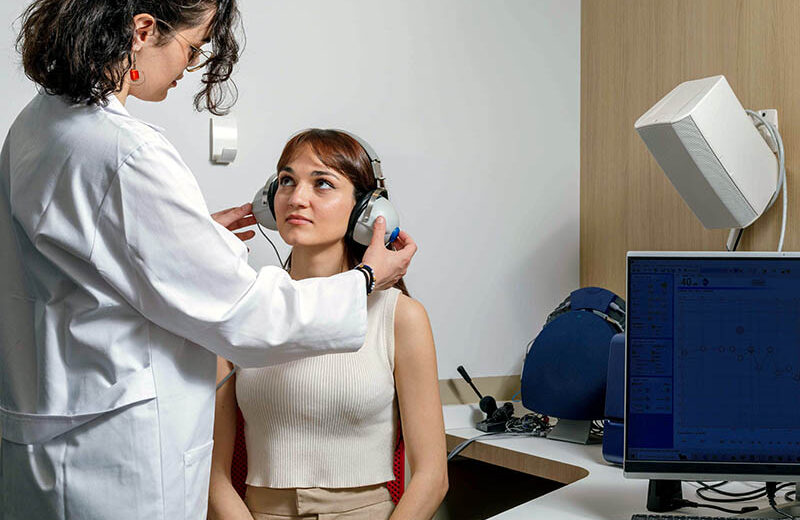An online test offers only a basic assessment, but that might be enough to answer important questions.
Hearing loss is a serious threat as we get older, affecting about a third of people ages 65 to 74, and half of those ages 75 or older. The impairment increases the risk for isolation, depression, dementia, and even premature death. Yet many people don’t go to an audiologist when they (or their families) suspect hearing changes, often because of accessibility, stigma, or misconceptions about hearing aids.
If you fit into one of those categories, consider trying a free online hearing test. “Many of these tests can be reliable under the right conditions. But results can vary, and I’d advise caution when using them. You need to know what they can and can’t offer,” says Meaghan Reed, director of Clinical Audiology at Mass Eye and Ear.
What’s an online hearing test?
An online hearing test provides a basic assessment of how well you hear. It comes in two forms. One simply asks you to fill out a questionnaire. The other involves donning your personal headphones or earbuds and listening to a variety of sounds, such as a series of pitches and tones or words and spoken over background noise.
Most online hearing tests are free, offered at the website of a health insurance company or a hearing aid maker (as an entry point to consider its products). Many hearing aid companies require you to provide your email or contact information.
Online hearing test benefits
An online hearing test has many benefits. Convenience tops the list, since you can conduct the test in the privacy of your own home, at any time you choose, without seeing a medical professional. Other benefits include the ability to
monitor your hearing from time to time, to check for changes
detect mild, moderate, or severe hearing loss
identify the particular pitch range that might be difficult for you, such as high-pitch hearing loss
identify differences in hearing ability in one ear compared to the other (asymmetry).
Online hearing test drawbacks
Both types of online tests provide only a limited assessment of your hearing. They can’t determine the type or cause of your hearing loss, and they can’t diagnose other conditions that might be related to your hearing issue.
An online test that asks you to listen to certain sounds has other drawbacks, too, such as the following.
Equipment snafus. The test relies on your own headphones or earbuds, which might not be calibrated to the hearing test and lead to inaccurate results.
Testing conditions. The test environment is not controlled. “Your results might not be as accurate as possible if you take the test in your car, where road noise might be louder than the sounds you’re trying to hear. Even noises such as air conditioners can cause interference and impact test results,” Reed says.
Limited abilities. The test results might not pick up hearing difficulties you perceive and lead to inconclusive results. And the test can’t incorporate other medical testing, such as a look into the ear canal, and it can’t adapt to people who have language barriers, difficulty understanding instructions or technology, or test anxiety.
What to do with the results
After taking an online hearing test, your next step depends on the results.
If the results suggest mild to moderate hearing loss and match your perceived difficulties, Reed says it then makes sense to try a pair of over-the-counter hearing aids. You can buy these online, in drugstores or big box stores, or from a hearing aid specialist.
“However, if the hearing aids aren’t adequately addressing your needs, you should seek a comprehensive hearing evaluation with an audiologist, and possibly a medical evaluation if you’re also having symptoms such as ringing or fullness in the ears, dizziness, or ear drainage,” Reed says.
You should also seek a comprehensive hearing test if your online hearing test results are inconclusive, suggest asymmetry between the ears, or didn’t pick up on hearing loss you perceive.
Comprehensive exams
A compressive hearing evaluation goes much further than an online hearing test. It involves going to an audiologist’s office, sitting in a small soundproof booth, donning special headphones calibrated to audiology equipment, and listening to certain sounds. “We try to assess the softest level you can hear across a variety of pitches,” Reed says. “We might also have you undergo tests that assess the function of the middle ear or certain medical tests to look for problems in the ear canal.”
Each test adds different pieces of information that lead to diagnosis and treatment — such as treating an underlying condition related to hearing loss or getting hearing aids (over-the-counter or prescription).
The goal is improving your hearing so you can take part in conversations, remain social, and ward off the risks of hearing loss. “An online hearing test gets that process started for many people,” Reed says. “The tool has a place in hearing health.”




